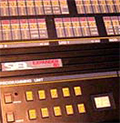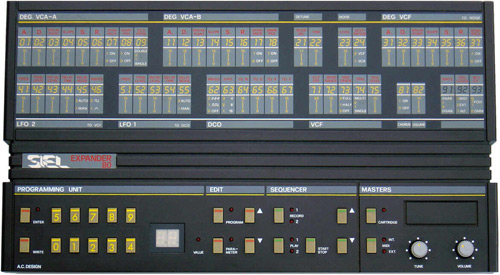
The Italian company Siel released their DK80 synth keyboard in 1985, which was a 12 voice analogue bitimbric (2 sounds at once) synth. The Expander 80 was also released at the same time (costing only £399, the cheapest instrument in it’s class by a long way) being essentially (but not just) half a DK80 – 8 voice polyphonic and one sound at a time.
Originally the Expander 80 was not supplied with a power supply, as the DK80 one was designed to drive the pair (Siel expected the DK80 owner to be the typcial owner of the Expander 80). The Expander 80 still retained the 300 event two track sequencer, although both tracks have to play the same sound. Similarities to the Korg EX800 cannot be ignored, especially as the voice architecture and front panel layout do have similarities. The Korg EX800 was released a year earlier in 1984, so the Siel Expander 80 definately followed it. Internally, they share no common electronics – so it’s no surprise they sound different

The Expander 80 architecture has 8 digitally controlled oscillators (DCO), 9 VCA’s (8 for the DCO’s and one for the noise generator) and a single 4-pole (24dB/octave) VCF (SSM2045), with nine 6-parameter digital envelope generators (8 for the VCA’s and one for the single VCF) plus 2 LFOs. A pink noise generator and analogue chorus are also included. A double mode, stacks 2 DCO’s together (4 note polyphonic) with detune – though the DCO’s have to share the same settings. In fact the oscillators and VCA’s are all on one chip (an M112 polyphonic sound generator), and the envelopes are under microproccesor control (a Texas TMS7000 in case you were wondering). The chorus is an analogue bucket brigade delay line (TDA1022).
The M112 chip contains a top octave generator with octave dividers, 5 footage outputs under VCA control, this is organ frequency divider technology rather thna synth voltage control technology, though it still remains analogue voice generation.
The Expander 80 block diagram:

LIMITATIONS
OK – the Expander 80 is not perfect, it has one major economy in it’s design, which it shares with the likes of the Korg Mono/Poly, Poly 800, EX800 and also the Moog Opus 3 (so it’s not alone) – it only has one VCF. If playing single notes (monophonic playing) no issue, if playing block chord stabs – no issue, but trying to play two hands at once will mean either notes not sounding again, or all notes retriggering with each new note played. The Expander 80 has a trigger mode for the user to decide which mode is best. There are some sounds when this retriggering effect can become a useful part of the sound, so it is not always a limitation!
The Expander 80 has 40 preset sounds (memories 00 – 39) and (only?!) 10 programmable sounds (memories 40 – 49). If memories 50-99 are selected, memory location selected minus 50 is called up. Extra memory is available on the optional (and very rare!) RAM cartridge, where a further 50 memory locations are available (memories 50 -99 with the Cartridge mode enabled). Siel did produce a preset ROM cartridge with 100 sounds on in two banks of 50.
ODDITIES
Like any synth there are oddities of the system, and the Expander 80 is no different here. One apparent feature of the oscillators, is that there appears to be four of them per note! Yes, so it will seem. There are eight oscillators (8 note poly single mode), and by stacking two under each key (4 note poly double mode), but each oscillator can be “detuned” to fatten it up. If put into whole mode – that is, using 8 note polyphony and one oscillator, the detune fine parameter still introduces a two oscillator detune effect. Then, putting the Expander 80 into Double mode using 4 note polypony and two oscillators, the detune fine works on this as well. DCO2 can be transposed chromatically anywhere up to nearly 5 octaves higher than DCO1 – both DCO’s have detune – it’s definately like having 4 oscillators. But – what is really happening is simply the chorus effect. There is no oscillator detune fine in the Expander 80 at all, as the detune fine simply brings in 15 levels of chorus, in fact the oscilators cannot be fine detuned, only in chromatic intervals.
As the detune fine is actually the chorus effect, this means that the DCO detune and the Chorus effect are exclusive. When the Chorus is switched on, the detune becomes unavailable. When the chorus is acting as “detune”, the chorus is mono output, though when it is used as a conventional chorus, it’s output is stereo.
Stereo output? Well, the Expander 80 does have two outputs – not that there is much stereo about it though. Unlike it’s keyboard brother – the DK80 – which being bitimbric could put a different sound to each output (allowing various auto panning effects), the one sound at a time Expander 80 can only put the same sound to both outputs. The Chorus effect is however stereo, though only by inverted phase on one side.
Who printed the panel wrong then? Parameter 21 (Detune Interval) goes up to a value of 61 – and not just 11 shown on the panel (this is a limitation of the DK80). Parameter 93 (MIDI Channel) goes up to a value of 16 – and not just 15 shown on the panel.
The Expander 80 does not seen to have any System Exclusive implementation, so no dumping of the sounds (see below for MIDI control though)
There seems to be a bug in the MIDI controller reception with the Expander 80, unless there ever was an operating system update, Parameter 22 (Detune Fine) and Parameter 81 (Chorus) cannot be controlled by their assocuiated controllers (CC30 and CC62). When receiving MIDI CC30, the Expander 80’s display changes to show the incoming data, but the actual detuning (chorus speeed) does not change, same with CC62. Maybe this was corrected in a software revision.